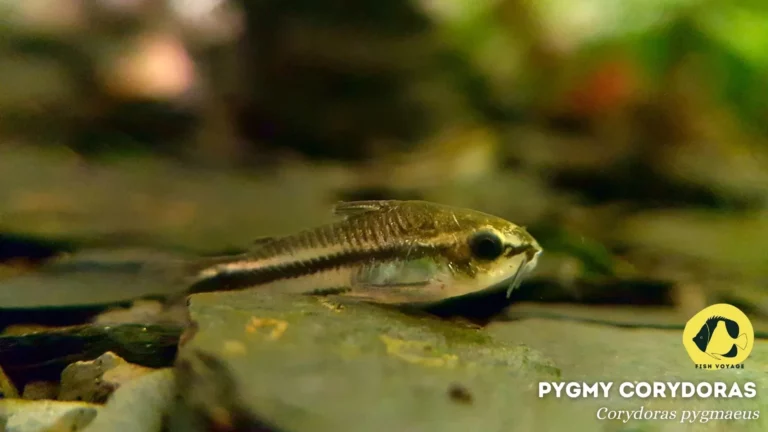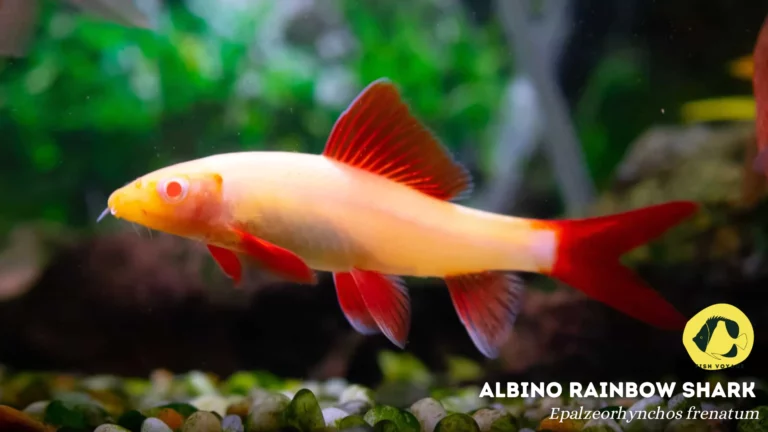The Guide to Emerald Dwarf Rasbora Tank Mates
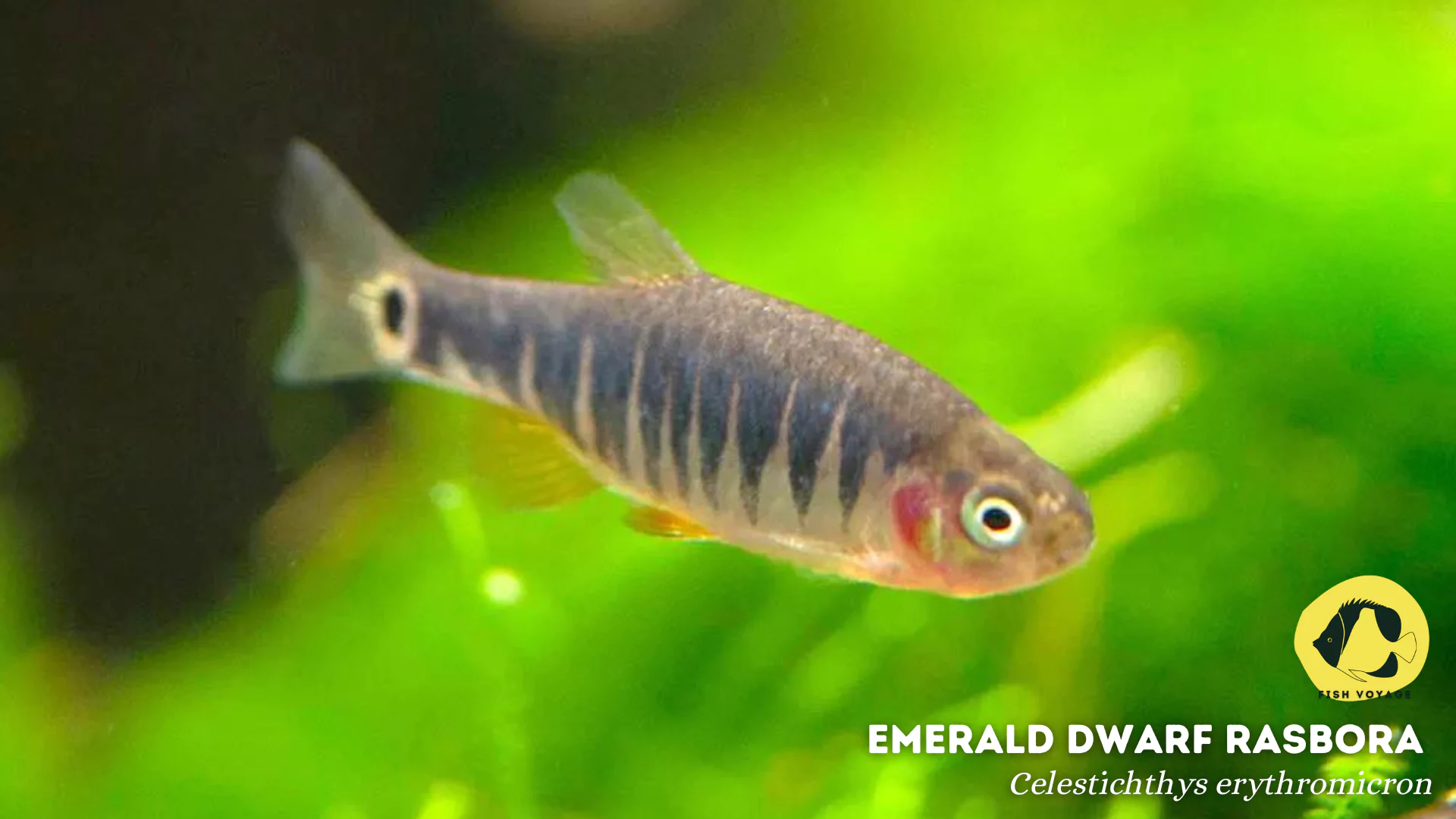
Welcome to our exploration of the captivating aquatic world, where the spotlight is on the enchanting Emerald Dwarf Rasbora. These vibrant little fish, known for their dazzling emerald hues and playful demeanor, have become favorites among aquarium enthusiasts. In this guide, we delve into not just the intricacies of the Emerald Dwarf Rasbora itself, but the critical aspect of selecting suitable tank mates. Choosing companions that harmonize with the unique characteristics of these rasboras is paramount for a thriving aquarium ecosystem.
As we embark on this journey, we not only emphasize the importance of compatibility but also promise valuable insights into the perfect tank mates, ensuring a picturesque and harmonious underwater haven for your aquatic companions. Join us in discovering the art of creating a community that thrives with diversity and mutual respect.
Characteristics of Emerald Dwarf Rasbora
Size and Appearance
- Petite Elegance: The Emerald Dwarf Rasbora, also known as Microrasbora erythromicron, boasts a petite yet captivating presence. With a maximum size of around 0.8 inches, these tiny emerald gems add a touch of elegance to any aquarium.
- Vibrant Emerald Hues: Dressed in a splendid coat of iridescent emerald green, these rasboras captivate onlookers with their radiant colors. Their streamlined body and distinctive forked tail enhance their visual appeal, making them a stunning addition to freshwater tanks.
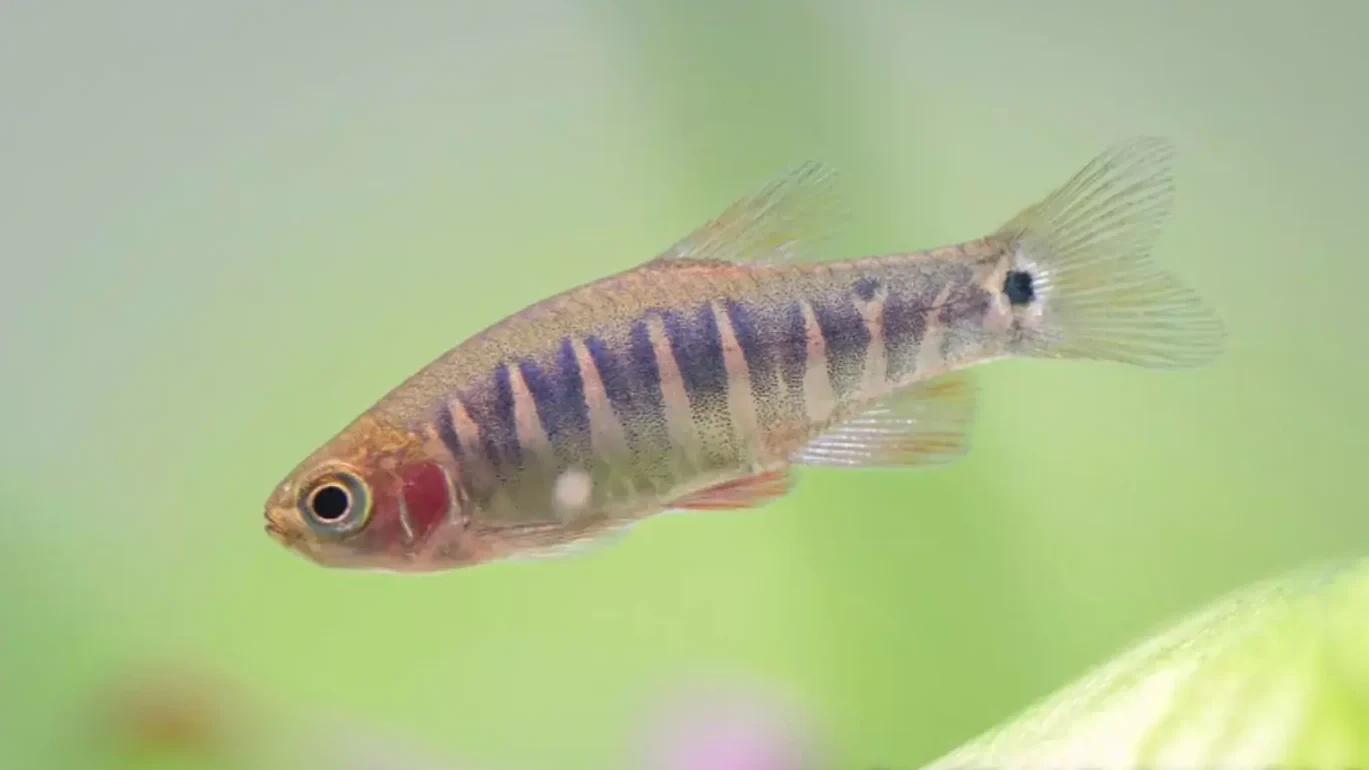
Behavior and Temperament
- Playful Socializers: Emerald Dwarf Rasboras are renowned for their playful and social nature. They thrive in groups, exhibiting lively shoaling behavior. Observing their synchronized movements creates a mesmerizing underwater ballet, enhancing the overall dynamics of the aquarium community.
- Peaceful Demeanor: With a gentle temperament, these rasboras coexist harmoniously with other non-aggressive species. Their peaceful nature makes them an excellent choice for community tanks, fostering a tranquil environment.
Special Care Requirements
- Diminutive Size, Delicate Needs: Due to their small size, precision in care is essential. Provide a well-planted tank with ample hiding spots to cater to their natural instincts. The addition of soft, acidic water mimics their native habitats, ensuring their well-being.
- Stable Water Parameters: Maintaining stable water conditions, including a temperature range of 73-79°F and a pH level between 6.0-7.5, is crucial. Regular water quality checks and adequate filtration contribute to the health and vitality of these delicate aquatic companions.
Embark on a journey into the nuanced world of Emerald Dwarf Rasboras, where their petite size conceals a world of vibrant beauty and fascinating behavior. Understanding their characteristics sets the stage for creating an ideal environment that enhances their natural splendor.
Benefits of Choosing Compatible Tank Mates
Creating a Harmonious Aquarium Environment
- Symphony of Diversity: Introducing compatible tank mates fosters a diverse and harmonious aquarium environment. Each species contributes its unique charm, creating a living tapestry that engages and captivates enthusiasts.
- Ecological Balance: A well-balanced community of fish, plants, and invertebrates mirrors the ecological harmony found in nature. This balance not only enhances the aesthetic appeal but also promotes a sustainable and thriving aquatic ecosystem.
Reducing Stress and Aggression Among Fish
- Stress-Free Living: Selecting tank mates with compatible temperaments minimizes stress levels among the inhabitants. The absence of aggression creates a calm atmosphere, allowing each fish to exhibit natural behaviors without the constant threat of territorial disputes.
- Optimal Health: Reduced stress correlates with improved health. Fish that coexist peacefully are more likely to exhibit vibrant colors, robust appetites, and overall well-being. By curbing aggression, aquarium enthusiasts contribute to the longevity and vitality of their aquatic companions.
Enhancing Overall Well-being of Emerald Dwarf Rasboras
- Social Interaction: Emerald Dwarf Rasboras thrive in the company of compatible tank mates. Shoaling behavior becomes more pronounced, enriching their social interactions and providing mental stimulation essential for their well-being.
- Natural Behavior Expression: In a community of like-minded companions, these rasboras express their natural behaviors more freely. From playful exploration to synchronized swimming, observing their innate actions enhances the overall satisfaction of both the enthusiast and the aquatic inhabitants.
Embark on a journey where the benefits of compatibility extend beyond aesthetics. By carefully curating a community that coexists harmoniously, enthusiasts contribute to the holistic well-being of their aquatic ecosystem. Witness the rewards of fostering a balanced and stress-free environment for every finned resident in your underwater haven.
Ideal Tank Mates for Emerald Dwarf Rasbora
Species Compatibility Considerations
- Similar Temperament Profiles: Choosing tank mates with comparable temperaments is paramount. Opt for peaceful species that share the gentle demeanor of the Emerald Dwarf Rasbora to ensure a tranquil coexistence.
- Size Harmony: Considering the petite size of the rasboras, selecting tank mates of similar size prevents accidental aggression or intimidation. Compatibility in size fosters a balanced and visually appealing community.
Community Tank Setups that Work Well
- Schooling Companions: Since Emerald Dwarf Rasboras thrive in schools, consider companions that exhibit schooling behavior, such as other small tetras or rasboras. This creates a visually stunning display and emphasizes their natural social tendencies.
- Bottom Dwellers and Mid-Water Swimmers: To utilize the entire aquarium space, incorporate bottom-dwelling species like small catfish or shrimp along with mid-water swimmers. This multi-level approach adds depth to the community tank and caters to the diverse preferences of different species.
Tips for Introducing New Tank Mates
- Quarantine Protocol: Prioritize the health of your aquarium by quarantining new tank mates before introduction. This precautionary step helps prevent the spread of diseases and ensures the well-being of existing inhabitants.
- Gradual Acclimatization: Ease the transition for both new and existing members by acclimating them gradually. Slowly introducing tank mates reduces stress and allows them to adapt to their new environment without disruption.
- Observation Period: Monitor interactions closely during the initial stages. Watch for signs of aggression or stress, and be prepared to make adjustments if necessary. A careful observation period ensures the seamless integration of new additions.
Embark on the journey of creating an ideal community for your Emerald Dwarf Rasboras, where compatibility isn’t just a consideration but a key to the flourishing of your aquatic companions. By understanding the nuances of species interaction and following thoughtful introductions, enthusiasts can curate an aquarium that mirrors the diversity and harmony of the underwater world.
Top 5 Recommended Tank Mates
Harlequin Rasbora (Trigonostigma heteromorpha)
Characteristics and Unique Features
- Vibrant Coloration: Harlequin Rasboras showcase a striking blend of orange, red, and silver hues, adding a burst of color to your aquarium.
- Similar Size: With a size range comparable to Emerald Dwarf Rasboras, Harlequins create a visually balanced and cohesive school within the tank.
Reasons for Compatibility
- Peaceful Coexistence: Both species share a peaceful temperament, minimizing the risk of aggression and fostering a harmonious community.
- Schooling Dynamics: Harlequin Rasboras exhibit schooling behavior, complementing the social nature of Emerald Dwarf Rasboras. The synchronized movements enhance the overall aesthetic appeal of the tank.

Pygmy Corydoras (Corydoras pygmaeus)
Characteristics and Unique Features
- Compact Size: Pygmy Corydoras are small and unobtrusive, making them an excellent choice for the lower levels of the tank.
- Bottom-Dwelling Behavior: Their preference for the substrate adds diversity to the aquarium, utilizing different levels of the tank.
Reasons for Compatibility
- Non-Intrusive Nature: Pygmy Corydoras are peaceful bottom dwellers, ensuring minimal interference with the activities of Emerald Dwarf Rasboras in mid to upper water levels.
- Social Harmony: Both species share a calm demeanor, contributing to a stress-free and sociable environment.
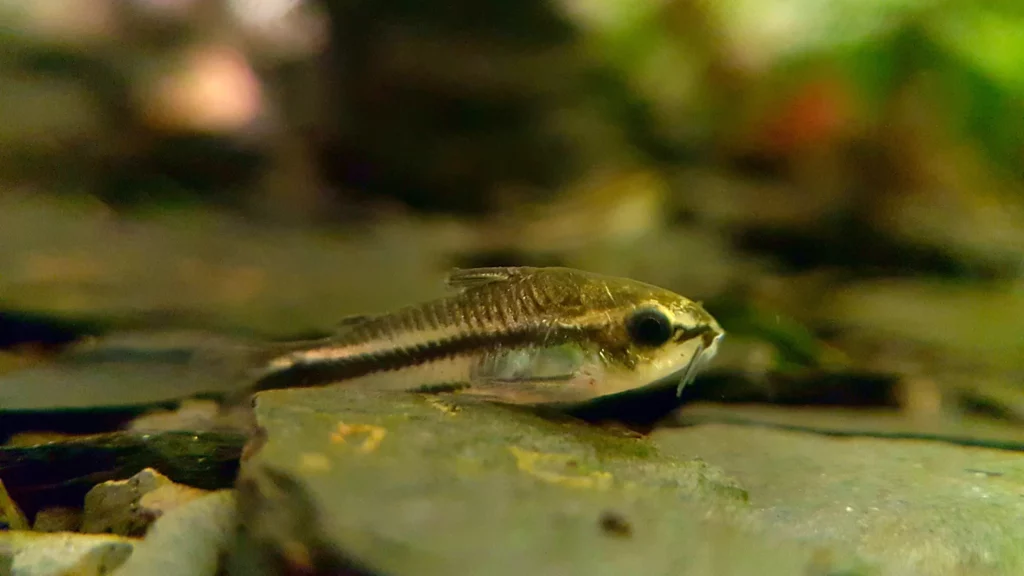
Cherry Barb (Puntius titteya)
Characteristics and Unique Features
- Rich Red Coloration: Cherry Barbs exhibit vibrant red hues, creating a visually captivating contrast with the emerald green of the rasboras.
- Active Swimmers: Their active and playful swimming patterns add liveliness to the aquarium.
Reasons for Compatibility
- Similar Temperament: Cherry Barbs are known for their peaceful nature, ensuring compatibility and reducing the likelihood of conflicts.
- Mid-Water Activity: Their mid-water swimming behavior complements the Emerald Dwarf Rasboras’ activities, providing a balanced and engaging community.

Otocinclus Catfish (Otocinclus affinis)
Characteristics and Unique Features
- Algae-Eating Expertise: Otocinclus catfish excel at algae control, contributing to the maintenance of a clean and healthy aquarium.
- Small Size: Their diminutive size makes them suitable for smaller aquariums and ensures they don’t compete for space with Emerald Dwarf Rasboras.
Reasons for Compatibility
- Algae Management: Otocinclus catfish help keep the tank free from algae, benefiting the overall aesthetics and water quality.
- Low Aggression Levels: Their non-aggressive nature aligns well with the peaceful temperament of Emerald Dwarf Rasboras.
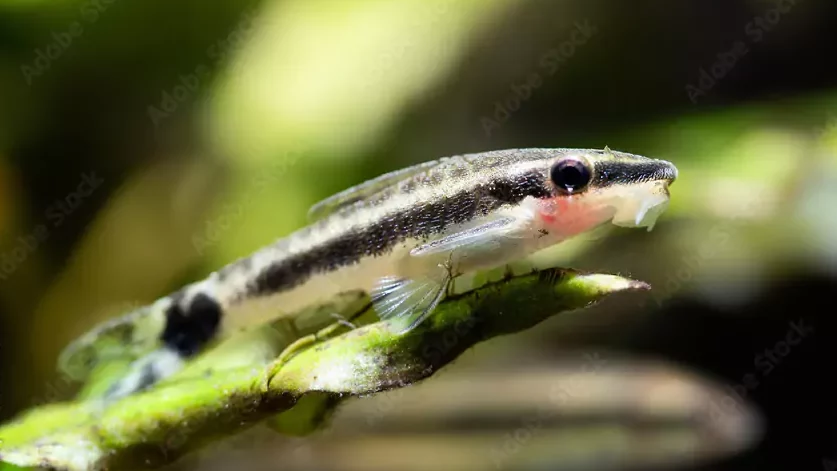
Celestial Pearl Danio (Danio margaritatus)
Characteristics and Unique Features
- Stunning Patterns: Celestial Pearl Danios boast intricate patterns and iridescent colors, adding visual appeal to the aquarium.
- Small Size: Similar in size to Emerald Dwarf Rasboras, they contribute to the overall balance of the tank.
Reasons for Compatibility
- Peaceful Disposition: Celestial Pearl Danios are known for their peaceful behavior, ensuring a serene and stress-free environment.
- Mid to Upper Level Swimmers: Their preference for the mid to upper levels complements the activity range of Emerald Dwarf Rasboras, creating a dynamic and engaging community.
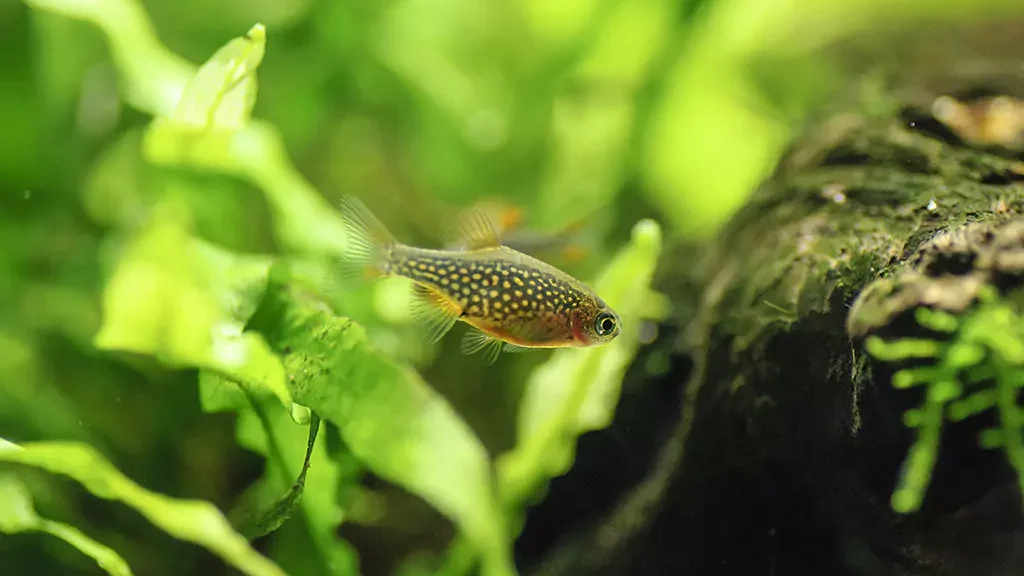
Embark on a journey of creating a diverse and visually stunning aquatic community with these carefully selected tank mates for your Emerald Dwarf Rasboras. Each species brings unique attributes that not only enhance the aesthetic appeal but also contribute to the overall well-being of your underwater companions.
Top 5 Incompatible Tank Mates
Red-Tailed Shark (Epalzeorhynchos bicolor)
Characteristics
- Territorial Behavior: Red-Tailed Sharks are known for their territorial nature, often claiming specific areas within the aquarium.
- Aggressive Demeanor: They can display aggression towards other fish, especially those with a similar body shape or size.
Reasons for Incompatibility
- Territorial Conflicts: The territorial habits of Red-Tailed Sharks may lead to conflicts with the schooling behavior of Emerald Dwarf Rasboras, causing stress and potential aggression.
- Size Disparity: The size difference between the two species may result in the Red-Tailed Shark intimidating the smaller rasboras.
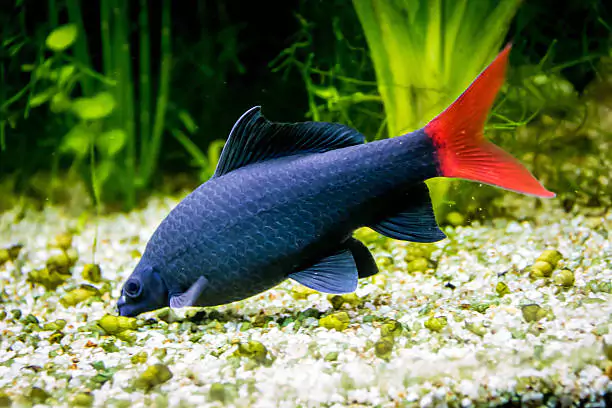
Betta Fish (Betta splendens)
Characteristics
- Aggressive Tendencies: Male Betta fish, in particular, are known for their territorial and aggressive behavior.
- Long Fins: Bettas often have long, flowing fins, which might attract their aggression towards smaller, active fish.
Reasons for Incompatibility
- Aggressive Interactions: The aggressive nature of Betta fish can pose a threat to the peaceful Emerald Dwarf Rasboras, leading to stress and potential fin nipping.
- Contrasting Activity Levels: Betta fish may become agitated by the active shoaling behavior of rasboras, resulting in an incompatible tank dynamic.
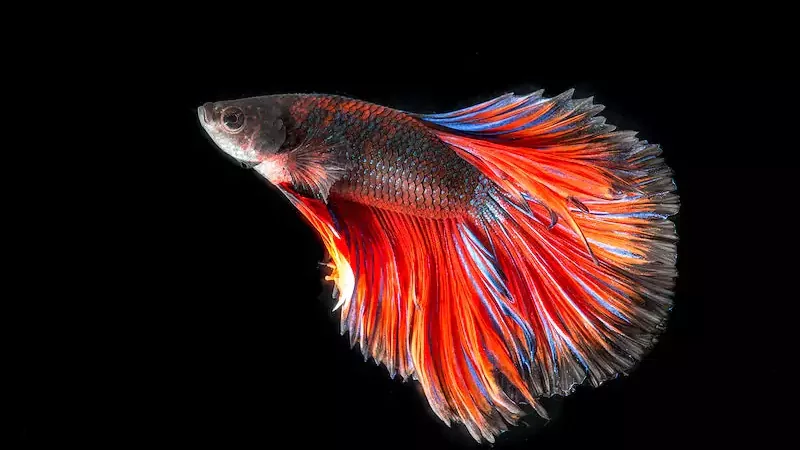
Jack Dempsey Cichlid (Rocio octofasciata)
Characteristics
- Large Size: Jack Dempsey Cichlids can grow significantly larger than Emerald Dwarf Rasboras, creating a potential power imbalance.
- Territorial Aggression: Cichlids, in general, exhibit territorial behavior, especially during breeding periods.
Reasons for Incompatibility
- Size Disparity: The substantial size difference between the Jack Dempsey Cichlid and rasboras may lead to predatory behavior or territorial disputes.
- Aggressive Nature: The territorial aggression of cichlids can pose a threat to the peaceful coexistence of Emerald Dwarf Rasboras.
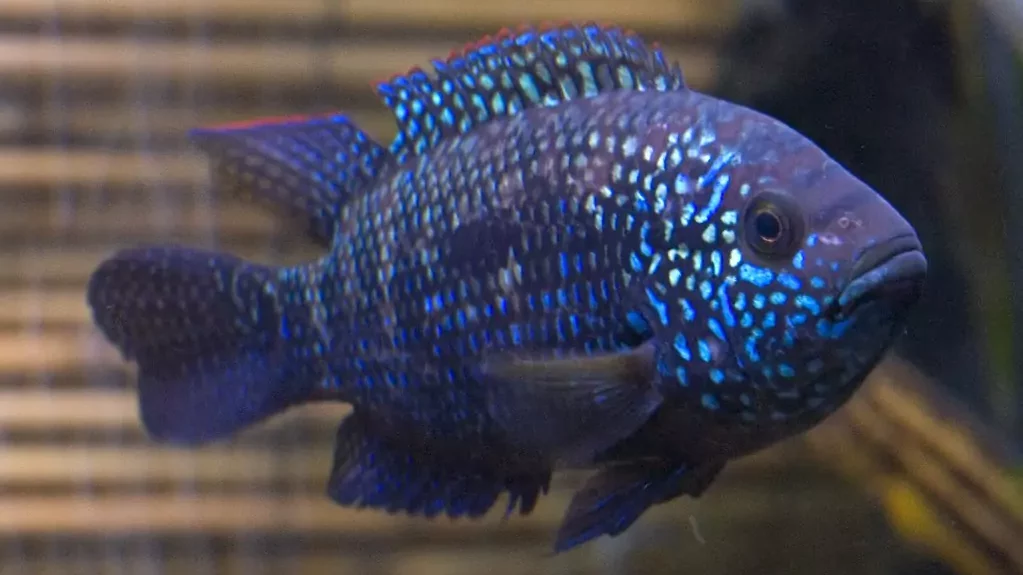
Tiger Barb (Puntigrus tetrazona)
Characteristics
- Fin Nipping Behavior: Tiger Barbs are notorious for their fin-nipping tendencies, particularly towards fish with long fins.
- Active Swimmers: Their active swimming behavior may disrupt the calm and harmonious shoaling patterns of Emerald Dwarf Rasboras.
Reasons for Incompatibility
- Fin Nipping Concerns: The fin-nipping behavior of Tiger Barbs can lead to stress and potential harm to the delicate fins of rasboras.
- Contrasting Activity Levels: The energetic nature of Tiger Barbs may create an incompatible tank environment for the more peaceful rasboras.
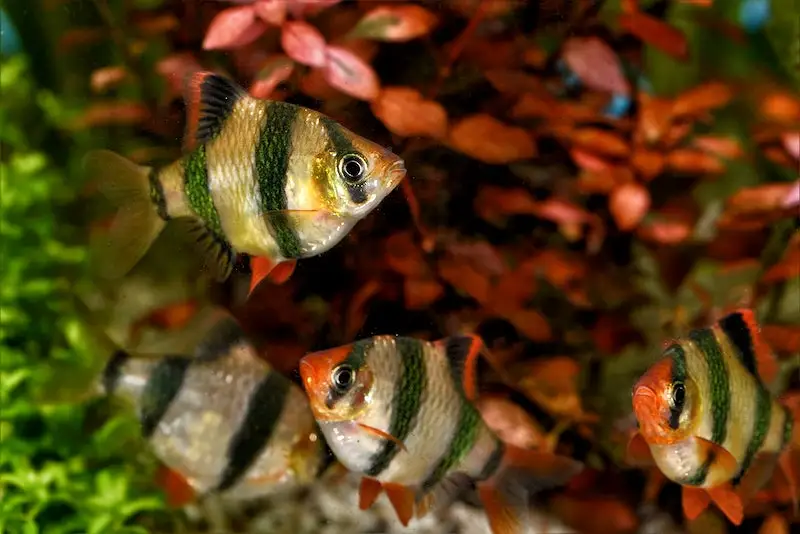
African Cichlid (Various Species)
Characteristics
- Diverse Species: African Cichlids encompass various species with differing sizes, colors, and aggression levels.
- Territorial Nature: Many African Cichlids are territorial, defending specific areas within the tank.
Reasons for Incompatibility
- Aggressive Interactions: The diverse and often territorial nature of African Cichlids may result in aggressive interactions, posing a threat to the well-being of Emerald Dwarf Rasboras.
- Competition for Space: The varying sizes and territorial habits of African Cichlids may lead to competition for space, creating an unstable environment for rasboras.
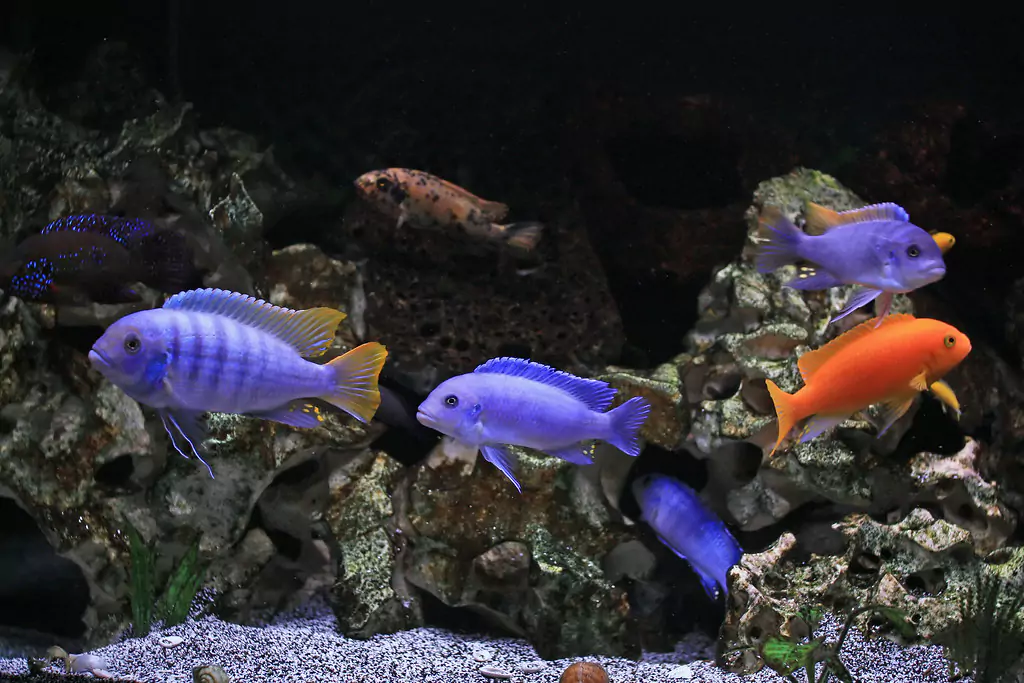
Navigate the delicate balance of creating a compatible aquatic community by avoiding these incompatible tank mates for your Emerald Dwarf Rasboras. Understanding the characteristics and potential conflicts helps ensure a serene and thriving environment for all inhabitants in your underwater haven.
Tank Mate Selection Guidelines
Size Compatibility
- Balanced Proportions: Select tank mates that share similar sizes to the Emerald Dwarf Rasboras to prevent potential conflicts arising from significant differences in size.
- Avoid Predatory Disparities: Be cautious about pairing with significantly larger species, as this may lead to predatory behaviors, jeopardizing the safety of smaller tank mates.
Dietary Considerations
- Similar Feeding Habits: Opt for tank mates that have compatible dietary preferences, ensuring all inhabitants receive adequate nutrition without competition.
- Avoid Aggressive Feeders: Steer clear of species that exhibit aggressive feeding behavior, as this can lead to stress and malnutrition among less assertive tank mates.
Temperature and Water Parameter Alignment
- Consistent Temperature Preferences: Choose tank mates that thrive in similar temperature ranges to maintain a stable and comfortable environment for all inhabitants.
- Aligned Water Parameters: Ensure that the preferred water parameters, including pH and hardness, are compatible among species to prevent stress and health issues.
- Research Species Requirements: Thoroughly research the specific requirements of potential tank mates to guarantee a cohesive and thriving community with Emerald Dwarf Rasboras.
Embarking on the journey of selecting tank mates for Emerald Dwarf Rasboras involves careful consideration of size, dietary habits, and environmental preferences. By adhering to these guidelines, enthusiasts can foster a harmonious and balanced aquatic community, where each species contributes to the overall well-being of the underwater ecosystem.
Potential Challenges and Solutions
Common Issues with Tank Mate Compatibility
Aggression and Territorial Disputes
- Issue: Aggressive behavior or territorial disputes among tank mates can lead to stress and harm.
- Solution: Observe interactions closely and, if necessary, provide additional hiding spots or rearrange the tank to establish new territories and reduce aggression.
Size Disparities
- Issue: Significant differences in size may result in predatory behaviors or intimidation.
- Solution: Choose tank mates with similar sizes to prevent potential harm. Avoid pairing Emerald Dwarf Rasboras with significantly larger or predatory species.
Troubleshooting Tips for Resolving Conflicts
Isolation and Observation
- Issue: Aggressive behavior observed.
- Solution: Temporarily isolate the aggressive individual, observe behavior, and reintroduce after implementing changes to the tank environment.
Rearrangement of Decor
- Issue: Territorial disputes or aggression.
- Solution: Rearrange tank decorations and hiding spots to disrupt established territories and reduce aggression. This can help reset the hierarchy among tank mates.
Introduce Diversionary Elements
- Issue: Fin-nipping or aggressive behavior.
- Solution: Introduce plants, decorations, or tank dividers to create visual barriers and reduce direct interactions, preventing conflicts.
Adjust Feeding Strategies
- Issue: Aggressive feeding behavior leading to stress.
- Solution: Implement feeding strategies such as spreading food across the tank or using feeding rings to ensure all tank mates receive adequate nutrition without competition.
Navigating potential challenges in tank mate compatibility requires proactive measures and attentive observation. By addressing common issues and employing troubleshooting tips, enthusiasts can maintain a peaceful and thriving aquatic community for their Emerald Dwarf Rasboras and other tank mates.
Conclusion
In conclusion, unlocking the secrets to a vibrant aquarium community with Emerald Dwarf Rasbora tank mates involves understanding their characteristics, selecting compatible companions, and addressing potential challenges. Remember the importance of size compatibility, dietary considerations, and maintaining aligned water parameters for a successful aquatic habitat.
Embark on your aquatic journey with confidence, armed with the knowledge to curate a thriving aquarium community. By choosing suitable tank mates, being mindful of compatibility factors, and addressing challenges proactively, you contribute to the well-being and harmony of your underwater haven. Create a dynamic and visually stunning environment where Emerald Dwarf Rasboras and their companions coexist in perfect balance.
Explore the diversity of aquatic life, share your experiences, and connect with fellow enthusiasts to foster a community that celebrates the beauty and intricacies of the underwater world. Your dedication to creating a harmonious aquarium reflects not only in the vibrant colors of your fish but in the satisfaction of witnessing a flourishing aquatic ecosystem. Happy fishkeeping!
Additional Resources
Reputable Forums
- Aquarium Enthusiast Communities: Explore engaging discussions and seek advice from experienced aquarium enthusiasts on reputable forums such as AquariumAdvice and Fishlore.
- Species-Specific Forums: Delve deeper into the specific needs of Emerald Dwarf Rasboras and their tank mates by joining communities like PlantedTank and TropicalFishForums.
- Reddit Aquarist Communities: Join the vibrant aquarium community on Reddit, where platforms like r/Aquariums and r/PlantedTank offer valuable insights and discussions.
Recommended Products
- Water Testing Kits: Ensure optimal water quality with reliable testing kits such as the API Freshwater Master Test Kit.
- Quality Fish Food: Nourish your Emerald Dwarf Rasboras with high-quality fish food like Hikari Micro Pellets, providing essential nutrients for their well-being.
- Tank Filtration Systems: Maintain a clean and well-filtered environment using efficient filtration systems such as the Fluval External Canister Filter.
- Aquarium Decor and Hiding Spots: Enhance the habitat with aesthetically pleasing decorations and hiding spots, including natural driftwood, live plants, and artificial caves from brands like majoywoo and PietyPet.
- Heaters and Thermometers: Regulate and monitor water temperature consistently with reliable aquarium heaters like the Eheim Jager TruTemp Submersible Heater.
- Aquascaping Tools: Perfect your aquascaping with precision tools such as aquascaping scissors, tweezers, and substrate leveling tools for meticulous maintenance from brands like Capetsma.
Explore these recommended products and forums to elevate your aquarium experience. Maintaining a healthy tank requires a combination of reliable equipment and access to knowledgeable communities, ensuring the well-being of your Emerald Dwarf Rasboras and fostering a thriving aquatic environment.
Frequently Asked Questions (FAQs)
1. What are suitable tank mates for Emerald Dwarf Rasboras?
Ideal tank mates include peaceful species like Harlequin Rasboras, Pygmy Corydoras, Cherry Barbs, Otocinclus Catfish, and Celestial Pearl Danios. Choose companions with similar temperaments and size compatibility.
2. Can Emerald Dwarf Rasboras coexist with Betta fish?
It is advisable to avoid pairing Emerald Dwarf Rasboras with Betta fish, especially males, due to Betta’s territorial and aggressive tendencies. These differences in behavior may lead to conflicts in the tank.
3. How do I introduce new tank mates to my Emerald Dwarf Rasbora aquarium?
Gradual acclimatization is key. Quarantine new additions, introduce them slowly to the tank, and closely monitor interactions. This minimizes stress and allows for a smoother integration process.
4. Are there potential challenges with tank mate compatibility for Emerald Dwarf Rasboras?
Yes, common challenges include aggression, territorial disputes, and size disparities. Observation, rearrangement of tank decor, and careful selection of compatible species can address and prevent these issues.
5. What should I do if I observe aggression among tank mates?
Isolate the aggressive individual temporarily, rearrange tank decorations to disrupt territories, and observe behavior closely. Reintroduce the isolated fish after making adjustments to create a more harmonious environment.



